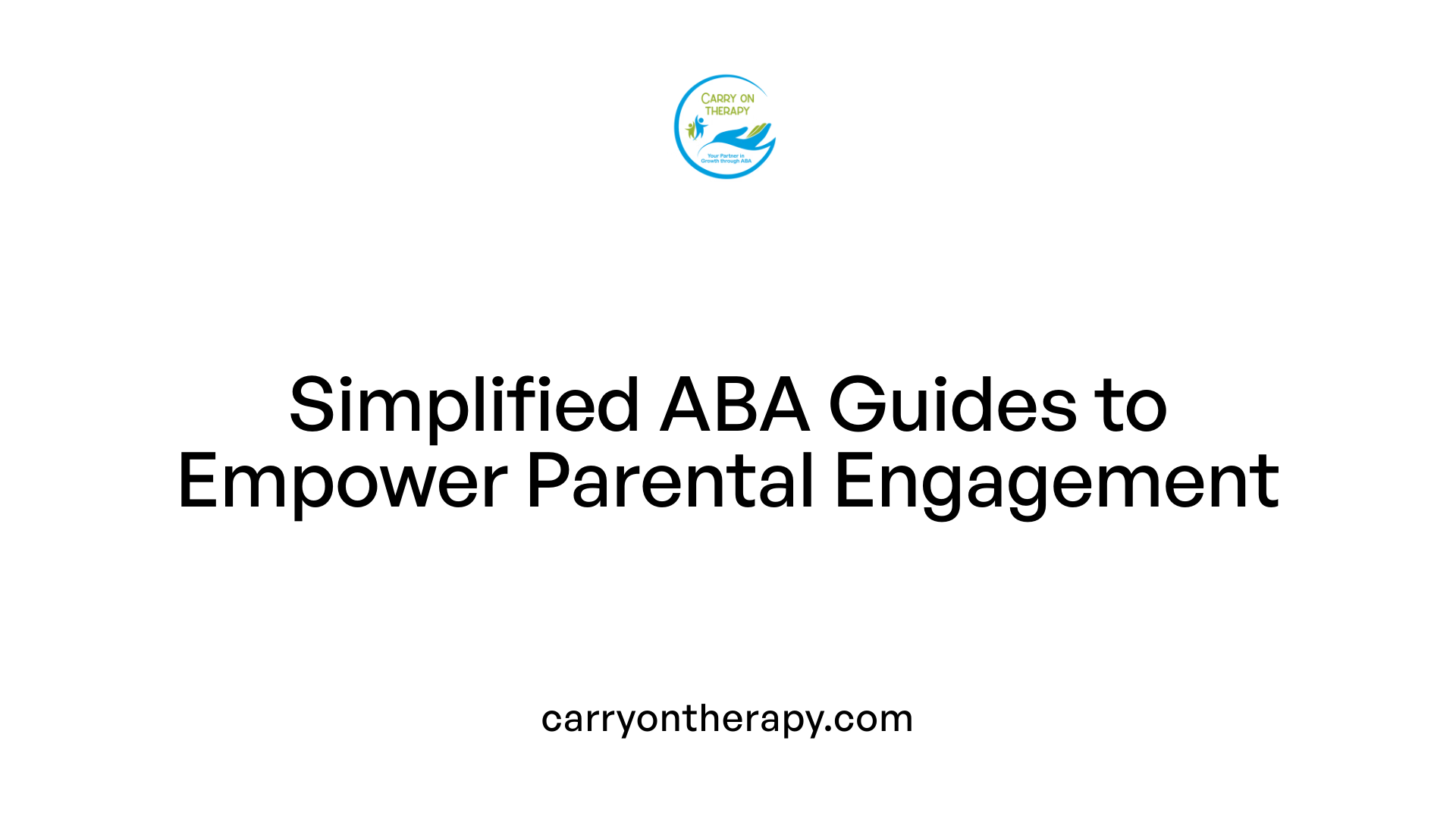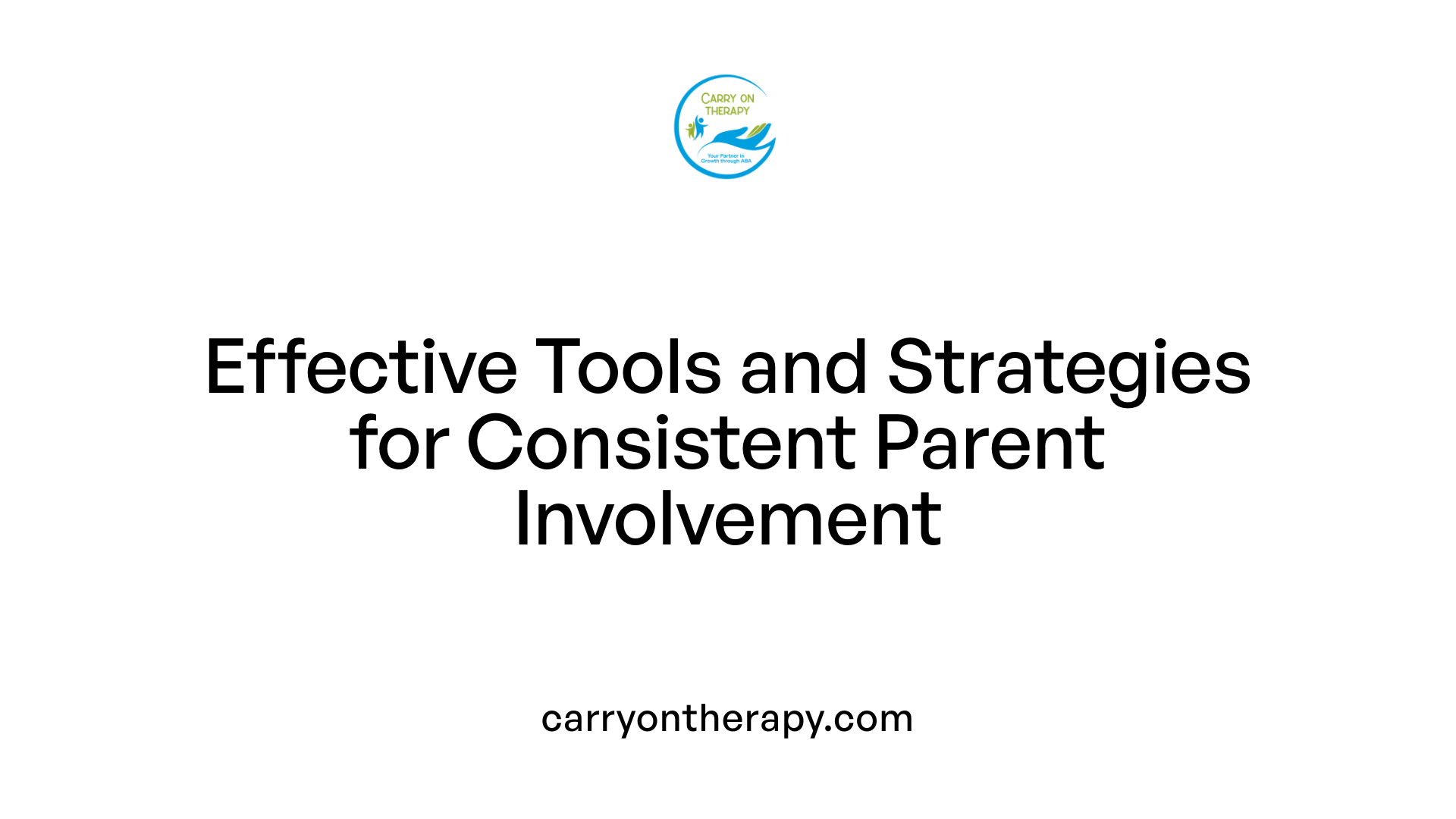Supporting Your Child’s Progress with Parent Involvement
Empowering Families: The Vital Role of Parent Involvement in ABA Therapy Success

Unlocking the Power of Partnership in Autism Intervention
Applied Behavior Analysis (ABA) therapy is a proven, science-backed approach that significantly improves the lives of children with autism spectrum disorder (ASD). Yet, one critical factor often shines through as a cornerstone of success: parent involvement. This article explores how parents can partner with therapy providers to support their child’s progress, the best ways to stay informed and engaged, and how tailored guidance empowers families to contribute meaningfully to their child's developmental journey.
Understanding ABA Therapy and Its Benefits for Children with Autism

What is Applied Behavior Analysis (ABA) therapy?
Applied Behavior Analysis (ABA) therapy is a scientifically validated method that uses principles of learning and behavior to support skill development and reduce challenging behaviors. It involves personalized plans designed to improve communication, social skills, academic abilities, and daily living skills. Techniques like reinforcement and data-driven adjustments help tailor interventions for each child. ABA therapy is effective across different ages, especially for children with autism spectrum disorder (ASD), and is implemented in settings such as home, school, and community. Trained professionals, including Board Certified Behavior Analysts (BCBAs), oversee the therapy ensuring it is evidence-based and progress is monitored.
What are some common techniques used in ABA therapy?
ABA employs various techniques to promote positive behavioral change:
- Positive Reinforcement: Rewarding desirable behaviors to increase their occurrence.
- Prompting: Providing cues to initiate behavior, gradually fading to encourage independence.
- Behavioral Chaining: Breaking tasks into small steps to facilitate learning.
- Modeling: Demonstrating behaviors for imitation.
- Extinction: Reducing unwanted behaviors by withholding reinforcement.
- Visual Supports: Using picture schedules or video modeling to teach and reinforce skills. Additional strategies include behavior contracts, script fading, and redirection, all designed to enhance social and communication skills tailored to individual needs.
Is ABA therapy evidence-based and effective for autism treatment?
Research strongly supports ABA therapy as an effective treatment for autism, focusing on improving communication, social interaction, and adaptive behaviors. Intensive, consistent ABA over one to three years during early childhood shows significant benefits. Modern approaches emphasize natural, play-based, and individual-focused interventions that foster skill generalization beyond therapy sessions. While some concerns exist about traditional ABA approaches, contemporary practices are more respectful of neurodiversity and prioritize independence. Overall, ABA remains one of the most widely endorsed therapies for children with autism.
Who typically provides ABA therapy for autism?
ABA therapy is delivered by trained professionals, primarily Board Certified Behavior Analysts (BCBAs), who design and supervise treatment plans. Registered Behavior Technicians (RBTs) or similarly trained paraprofessionals provide direct therapy under BCBA oversight. These specialists have expertise in behavior analysis and autism interventions, ensuring individualized and effective support. Collaboration with families and healthcare providers is common to maintain consistency and achieve optimal outcomes.
The Crucial Role of Parents in ABA Success
Impact of parent involvement on child progress
Parental involvement is vital in ABA therapy for children with autism. Research consistently shows that when parents actively participate, children experience improved social, academic, and behavioral outcomes. Parents help extend learning beyond therapy sessions, making skills learned more meaningful and applicable in everyday life. This involvement ensures that targets set during therapy are reinforced at home, promoting steady progress toward developmental goals.
Parental reinforcement and skill generalization
One of the significant benefits of parental engagement is the generalization of skills across different environments such as home, school, and the community. Parents implementing ABA strategies consistently help maintain and strengthen positive behaviors. Data collection and visual tools like graphs enable parents to monitor progress and collaborate effectively with professionals to adjust interventions as needed. This consistent reinforcement across settings ensures that skills are not only learned but sustained over time.
Emotional and relational benefits of parental engagement
Beyond behavioral gains, parental involvement fosters emotional support and strengthens the parent-child bond. Parents gain a deeper understanding of their child’s needs and develop the confidence to support their child’s growth. Services like those offered by Strive ABA Consultants, providing training and coaching, empower parents, which in turn creates a nurturing environment conducive to learning and development.
By blending structured ABA principles with parental participation, therapy becomes a collaborative effort. This partnership not only maximizes skill development but also enriches family dynamics, offering children with autism the best opportunity to thrive.
Bridging the Gap: Making ABA Principles Accessible to Parents

What Challenges Do Parents Face in Understanding ABA?
Many parents find the principles of Applied Behavior Analysis (ABA) complex and overwhelming. The technical language and specialized concepts, such as reinforcement and data collection, can be difficult to grasp without clear explanation. These challenges may limit their ability to fully engage in their child's behavioral interventions, potentially affecting the child’s progress.
Why Are Concise, Tailored Parent Guides Important?
Providing parents with clear, concise, and tailored guides helps bridge this understanding gap. Such guides facilitate better communication between families and school personnel, including teachers and behavior specialists. Tailored guides acknowledge each family's unique circumstances, allowing parents to feel more confident and involved in applying ABA strategies at home.
What Should Parent Guides Include?
Effective parent guides should cover several essential elements:
- Explanation of ABA Principles: Simple descriptions of core concepts like reinforcement and behavior modification.
- Behavior Intervention Plans (BIP): A summary of the child’s specific behavioral goals and strategies.
- Intervention Descriptions: Clear outlines of the techniques used during therapy sessions.
- Data Collection and Graphing: Visual aids such as graphs help parents track their child's progress and understand the importance of consistent intervention.
With these components, parents can better support and reinforce their child’s behavioral goals, enhancing the overall success of ABA therapy.
Collaborative Strategies Between Families and Professionals

How Do School Personnel Support Parent Training in ABA?
Teachers, psychologists, and behavioral specialists play vital roles in supporting parents through ABA interventions. These professionals often understand ABA principles and help implement interventions tailored to each child's needs. They can develop or customize clear, concise parent guides that make ABA concepts easier to grasp. This collaborative effort ensures consistency in applying strategies between school and home.
Why Consult Behavior Analysts When Customizing Parent Guides?
Behavior analysts bring specialized expertise in ABA, providing valuable insights during the creation of parent resources. By consulting with these analysts, school staff can produce customized guides that address the unique behaviors and learning goals of the child. This collaboration promotes accurate adherence to intervention plans and supports better tracking of behavioral progress through data and graphs.
How Does Open Communication and Collaborative Goal Setting Benefit Families?
Open communication between families and professionals fosters trust and mutual understanding. When parents and school personnel work together to set clear, achievable goals, this alignment leads to more effective interventions. Collaborative goal setting empowers parents to confidently support their child's learning at home. It also facilitates ongoing monitoring and timely adjustments, reinforcing the child's development across settings.
These collaborative strategies not only enhance the consistency and effectiveness of ABA interventions but also strengthen the partnership between families and educators, ultimately contributing to improved outcomes for children.
Tailoring Parental Involvement to Family Needs and Challenges
How do stress, socioeconomic status, and education level influence parental involvement?
Parental involvement in ABA therapy can be significantly affected by various factors such as stress, socioeconomic status, and education level. High stress levels often reduce a parent's capacity to engage fully in intervention efforts. Families with higher socioeconomic status generally have better access to resources and support systems, facilitating increased involvement. Conversely, limited financial means or lower education levels may hinder a parent's ability to understand or implement ABA strategies effectively.
What effects do cultural differences and language barriers have on parental involvement?
Cultural differences and language barriers pose additional challenges that can impact communication between parents and professionals. These obstacles may lead to misunderstandings or reduced confidence in participating in intervention planning. Recognizing and addressing these issues is essential to ensure parents feel supported and empowered to contribute actively despite cultural or linguistic challenges.
How can the level of parental engagement be balanced for diverse families?
There is no one-size-fits-all approach to parental involvement; it should be tailored to each family's unique circumstances. Understanding family stress levels, cultural background, language proficiency, and available support helps professionals customize engagement strategies. Striking this balance ensures parents are neither overwhelmed nor under-involved, promoting sustainable participation that benefits the child's progress across home, school, and community settings.
Practical Tools to Enhance Parent Participation at Home

Using Data and Graphs to Track Progress
Visual aids like graphs play an essential role in helping parents understand their child's behavioral progress. By presenting data collected during ABA interventions in an easily accessible format, parents can see real-time progress and areas needing attention. This clarity helps them set realistic goals and reinforces the importance of consistent involvement.
Training Parents to Implement and Reinforce Techniques
Parent training is critical in equipping families with the skills to reinforce ABA techniques outside therapy sessions. Tailored guides and hands-on coaching enable parents to apply ABA principles such as reinforcement, shaping, and data collection effectively. This not only supports skill generalization across home, school, and community environments but also ensures continuity and consistency, vital for sustained progress.
Examples of Parent Training Sessions and Hands-On Coaching
Programs like Strive ABA Consultants offer collaborative goal setting and training sessions where parents practice implementing strategies under professional guidance. Through modeling and live coaching, parents learn to manage behaviors and foster their child's development confidently. These sessions are customized to address individual family needs, enhancing engagement and strengthening the parent-child relationship.
Together, these tools empower parents as active partners in their child's ABA therapy, improving outcomes and nurturing a supportive environment at home.
Maximizing Outcomes Through Consistent Parental Involvement

How Ongoing Parental Reinforcement Supports Maintenance of Skills
Consistent reinforcement of positive behaviors by parents plays a vital role in maintaining and strengthening skills acquired through ABA therapy. When parents apply ABA principles such as reinforcement regularly at home, the child's learning is solidified beyond therapy sessions. This continuity helps prevent regression and supports sustained progress over time, ensuring that newly developed skills become part of the child’s daily life.
Generalization of Learned Behaviors Across Home, School, and Community
Parental involvement is essential in promoting the generalization of behaviors, meaning that children are able to apply skills learned in therapy across multiple environments. Parents who actively support their child’s interventions help bridge what is practiced during therapy with real-life situations at home, in school, and within the community. This broad application leads to more meaningful and functional skill use that benefits the child's overall development.
Strengthening Family Dynamics and Parent-Child Bonds Through Involvement
Engaged parents not only enhance their child’s behavioral and academic outcomes but also foster stronger emotional bonds. Understanding and participating in their child’s ABA program empowers parents with knowledge and skills, reinforcing a nurturing and supportive relationship. This connection improves communication, increases emotional support, and positively influences family dynamics, providing a foundation for ongoing growth and success in the child's development.
Empowering Parents to Champion Their Child's Growth
Parental involvement is not just a support element in ABA therapy; it is a vital component that significantly influences a child's progress and long-term success. Educating and empowering parents with clear information, collaborative strategies, and practical tools enables them to become effective partners in their child's developmental journey. Tailoring involvement to each family's unique circumstances and fostering communication between families and professionals ensures that interventions are meaningful and effective. Ultimately, when parents actively participate and reinforce ABA strategies consistently, they not only enhance their child's skills and independence but also strengthen the family bond, nurturing an environment where growth and confidence flourish.
References
- Helping Parents Understand Applied Behavior Analysis
- The Role of Caregiver Involvement in ABA Therapy
- Parental Involvement in ABA Therapy for Children with ...
- Parent Involvement in ABA Therapy
- Applied Behavior Analysis (ABA)
- ABA Techniques: Strategies for Behavior Analysts - GSEP Blog
- ABA Therapy Examples, Definition & Techniques







